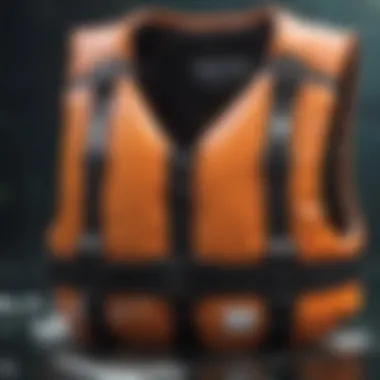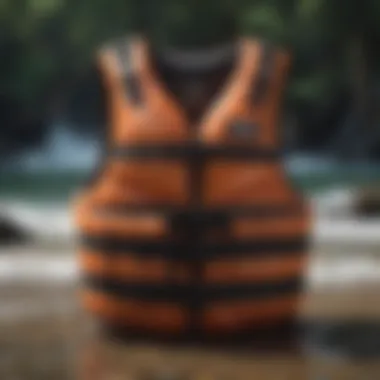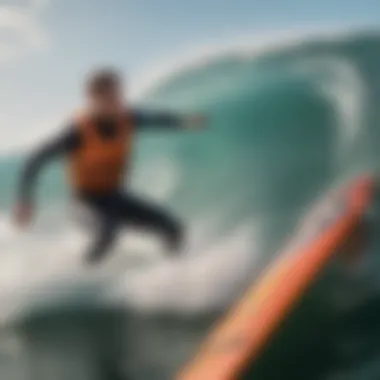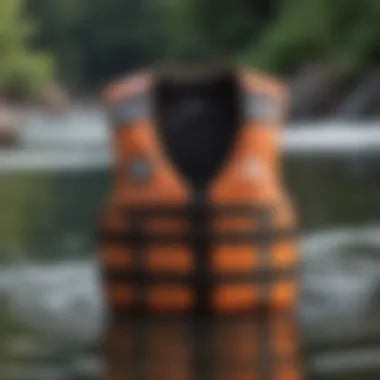The Crucial Role of Flotation Vests in Extreme Sports


Intro
Flotation vests serve a pivotal role in the realm of extreme sports. Their primary function goes beyond merely keeping individuals afloat; they contribute significantly to safety and performance across various high-adrenaline activities such as surfing, kayaking, and wakeboarding.
Understanding the design, functionality, and regulatory standards surrounding flotation vests is essential for both enthusiasts and professionals in these sports. In addition to providing buoyancy, the right vest can enhance an athlete's mobility and confidence, thus directly impacting their performance. However, selecting the appropriate flotation gear requires careful consideration of individual needs and the specific demands of each sport.
Through this exploration, we delve into the types of flotation vests available, the safety standards they must meet, and practical tips to ensure that participants can fully enjoy their experiences while minimizing risks. The nuances of flotation vests are not just for casual practitioners; they are essential knowledge for those deeply immersed in extreme sports.
Equipped with robust insights from this article, readers can make informed choices, ultimately safeguarding their adrenaline-fueled pursuits.
Preamble to Flotation Vests
Flotation vests serve as critical safety equipment for anyone engaged in water-related extreme sports. Their design and function are specifically tailored to enhance buoyancy and equip users with confidence in potentially hazardous conditions. This article delves into the essential aspects of flotation vests, emphasizing their role and importance in various extreme sports. Understanding the characteristics, types, and regulatory factors related to flotation vests greatly contributes to the safety and overall experience of adventure enthusiasts.
Definition and Purpose
A flotation vest is a personal flotation device (PFD) designed to keep a person afloat in water. Unlike traditional life jackets, flotation vests prioritize mobility while offering buoyancy. They are made to provide both support and comfort, enabling the user to engage effectively in activities like kayaking, jet skiing, and surfing. The main purpose is to prevent drowning by ensuring that the wearer remains at the surface of the water, even if unconscious. One innovative feature of flotation vests is their ability to maintain buoyancy without restricting movement, which is vital for high-intensity sports.
Importance in Extreme Sports
The importance of flotation vests in extreme sports cannot be overstated. In disciplines that often involve unpredictable water conditions, having the right gear can mean the difference between life and death. For instance, in surfing, where waves can be powerful and unpredictable, flotation vests offer both buoyancy and a sense of security. In kayaking, the risk of capsizing increases the need for reliable flotation devices.
"Always consider your safety first. A flotation vest can be your best companion on the water."
The presence of flotation vests significantly enhances safety levels across various extreme sports. They help athletes stay afloat while minimizing the risk of drowning. The requirement for these vests is often built into safety regulations for competitions, reinforcing their necessity in both recreational and competitive scenarios.
In summary, flotation vests are indispensable for extreme sports enthusiasts, promoting safety and boosting confidence in challenging environments. Their design caters to the specific needs of users, making them versatile gear for anyone aiming to enjoy water-based activities.
Types of Flotation Vests
Flotation vests are tailored for various water activities, each type serving a unique purpose and addressing specific needs of athletes and enthusiasts. Understanding the distinctions among these types helps in selecting the right gear, which is essential for safety, comfort, and performance in extreme sports. The variety ensures that participants can choose vests that best align with the demands of their chosen activities.
Life Jackets vs. Flotation Vests
Life jackets are designed primarily for buoyancy and emergency situations. They typically have higher buoyancy ratings and are built to turn an unconscious person face up in the water. In contrast, flotation vests are more streamlined and allow for greater freedom of movement, making them ideal for activities where agility is crucial, such as wakeboarding or surfing. While life jackets prioritize safety, flotation vests balance buoyancy with flexibility.
Inflatable Flotation Vests
Inflatable flotation vests are lightweight and compact. They are often favored by those engaged in high-speed activities because they provide enhanced mobility compared to their non-inflatable counterparts. When submerged, these vests automatically inflate, providing necessary buoyancy. This feature makes them particularly useful for kayaking and jet skiing, as they do not impede movement until needed. However, a potential drawback is that maintenance is crucial; leaks can occur over time, reducing their effectiveness.
Non-Inflatable Flotation Vests
Non-inflatable flotation vests offer continuous buoyancy without the need for inflation. These vests tend to be sturdier and are made from materials designed to withstand harsh conditions. They do not require maintenance related to inflation mechanisms. For extreme sports like surfing, many enthusiasts prefer these vests since they offer reliability during high-impact falls. However, they might feel bulkier compared to inflatable options, which can be a consideration during high-mobility activities.
Specialized Vests for Different Sports
Surfing
Surfing demands a flotation vest that allows for both support and flexibility. Many surfing vests employ a design that minimizes water resistance. The key characteristic is their streamlined shape, which means they do not hinder paddling. A popular choice includes materials that dry quickly and feature a surf leash attachment, ensuring the vest stays close during wipeouts. The unique buoyancy distribution can help surf practitioners maintain stability in stronger currents, making it a favourable option when surfing big waves.


Kayaking
In kayaking, the need for arm movement is critical. Consequently, flotation vests for this sport are often cut shorter to avoid bulk around the arms. They often include pockets for essentials like snacks or a whistle. The breathable material is another important feature, as it does not trap heat or moisture during long paddling sessions. This makes kayaking vests a top choice among enthusiasts who value both safety and comfort on the water.
Wakesurfing
Wakesurfing combines the thrill of surfing with the speed of boat action. The specific aspect of wakesurfing vests is their focus on buoyancy in the rear while allowing for agility in the front. They are usually lightweight and equipped with softer edges to prevent chafing when riding waves continuously. An advantage is that many wakesurfing vests also feature built-in life jackets compliance while still catering to the unique movements of the sport, making them highly functional.
Jet Skiing
Jet skiing is intense, with rapid movements and potential for falls. Vests for this activity are designed with added buoyancy, ensuring that the rider remains afloat even after high-speed accidents. Many jet skiing flotation vests come with built-in harness systems, which can be attached to the ski for additional security. However, the bulkiness might be a downside for some riders, as it can restrict movement during high-paced rides. It is a trade-off between safety and agility that each rider must weigh carefully.
Key Features of Quality Flotation Vests
Flotation vests play a crucial role in ensuring safety for individuals engaged in extreme sports. Selecting a vest with quality features enhances the user's assurance while participating in high-adrenaline activities, allowing for both safety and performance. The following key features are important when considering a flotation vest:
Buoyancy Ratings
Buoyancy ratings indicate the level of buoyancy a flotation vest provides. It is essential to choose a vest that meets or exceeds the buoyancy requirement for the sport involved. A good buoyancy rating ensures that the vest supports the wearer effectively in water, reducing the risk of drowning during unexpected situations. Standards often define various buoyancy levels:
- Type I: Suitable for rough waters, it offers the highest buoyancy.
- Type II: Designed for calmer waters, it provides less buoyancy than Type I.
- Type III: Recommended for those who are confident in the water; it offers good buoyancy but is less effective in rough conditions.
Understanding these ratings can help sport enthusiasts select the appropriate flotation vest.
Material and Durability
The material used in flotation vests affects their durability and overall performance. Quality flotation vests are typically made from high-grade materials that resist wear and tear over time. Common materials include:
- Nylon: Strong and lightweight.
- Neoprene: Offers excellent insulation and comfort.
- Polyester: Resistant to UV rays, ideal for outdoor sports.
In addition to the material, attention to stitching and seams is vital; reinforced seams enhance durability and performance under stress. A vest that withstands harsh conditions not only prolongs its lifespan but also maintains integrity during critical situations.
Adjustability and Fit
Adjustability is a key element of flotation vests, as a proper fit is essential for both safety and comfort. Vests with adjustable straps allow users to customize the fit, ensuring that the vest stays in place during movement. A loose vest may shift in water, thus impeding safety. Key points to consider include:
- Side Straps: These should be easily adjustable for a snug fit.
- Chest Straps: These maintain the vest’s position without excessive tightness.
- Size Options: Vests should come in multiple sizes to cater to various body types.
A well-fitted flotation vest enhances performance, allowing for better freedom of movement while providing the necessary safety features.
Visibility Features
Visibility is a critical aspect of flotation vests, particularly in water sports where conditions can rapidly change. Bright colors and reflective materials improve the wearer's visibility to others, which can be lifesaving in emergencies. Factors to consider in visibility include:
- Color: Neon colors like orange and yellow are generally more visible.
- Reflective Strips: These enhance visibility during low light conditions, such as early morning or late evening.
Purchasing a vest with strong visibility features is a proactive measure for enhancing safety during extreme sports activities. It helps ensure that rescue operations can identify and assist the user swiftly if needed.
Regulatory Standards for Flotation Vests


When engaging in extreme sports, the safety and reliability of your equipment are paramount. Regulatory standards for flotation vests play a significant role in ensuring that these essential safety devices perform as intended. These standards encompass a series of guidelines and benchmarks developed by various organizations to guarantee that flotation vests provide adequate buoyancy, durability, and usability in emergency situations.
The relevance of these standards cannot be overstated. They serve multiple purposes:
- Safety Assurance: Compliance with safety standards reduces the likelihood of accidents resulting from gear failure.
- Quality Control: They ensure that flotation vests undergo rigorous testing, maintaining consistent quality across various brands and models.
- Consumer Confidence: Awareness of these standards helps consumers make informed decisions. It instills confidence that their flotation vests will perform effectively in life-threatening situations.
In summary, understanding regulatory standards equips users with knowledge about the necessary protections during extreme sports activities, ultimately enhancing safety.
International Safety Standards
Internationally recognized safety standards are essential for standardizing flotation vest design and functionality. Organizations such as the International Organization for Standardization (ISO) define criteria that flotation vests must meet to be classified as safe for use in water-related activities.
Some critical points surrounding these international standards include:
- Buoyancy Evaluation: Vests are tested for their buoyancy levels to ensure they can support users effectively.
- Durability Tests: Flotation vests undergo stress testing to examine their capacity to withstand rigorous conditions in extreme sports.
- Visibility Requirements: Many standards require flotation vests to incorporate specific colors or reflective materials to enhance visibility.
Adhering to these standards not only enhances user safety but also helps manufacturers design better products that are compliant with recognized guidelines.
Regional Regulations and Compliance
In addition to international standards, various regions have established their regulations concerning flotation vests. These regulatory bodies address local conditions, differing water sports, and cultural practices. Compliance with regional regulations is crucial for ensuring the safety and legality of using flotation vests in those areas.
Key considerations include:
- Local Laws: Different states or countries may have distinct regulations regarding flotation devices. Being aware of these can ensure compliance with legal requirements when participating in extreme sports.
- Specific Standards for Activities: Certain regions may set higher standards based on the prevalence of specific activities, like surfing or jet skiing, ensuring that flotation vests are optimized for those environments.
- Accreditation: Regional authorities often certify flotation vest manufacturers, requiring them to meet specific production and design standards.
In essence, regional regulations complement international guidelines, tailoring safety measures to local contexts. This dual-layer approach helps ensure a safer experience for adventurers engaged in extreme sports.
Safety Considerations When Using Flotation Vests
Safety considerations are paramount when using flotation vests, especially in extreme sports. The nature of these activities inherently involves risks. Hence, understanding how to maximize safety through proper use of flotation gear is critical. This section will delve into the essential elements that enhance safety when engaging in high-adrenaline pursuits such as surfing, kayaking, or jet skiing.
Reading Manufacturer Instructions
Every flotation vest comes with specific instructions provided by the manufacturer. These instructions outline proper usage and care. Understanding these details is crucial for the effectiveness of the vest. Ignoring the guidelines can lead to improper use, which in turn defeats the purpose of having a flotation device. For instance, some vests may require specific adjustments to achieve correct fit and buoyancy.
Moreover, these instructions also cover maintenance practices. Many individuals overlook this aspect, thinking that flotation vests are low-maintenance. However, following manufacturer guidance can ensure the vest remains in optimum condition and functions effectively when needed.
Regular Maintenance and Checking
Regular maintenance of flotation vests cannot be overstated. Users should inspect their vests before every use. Checking for any signs of wear, abrasions, or damage is necessary to ensure reliability. This includes looking for tears in the fabric, verifying the integrity of buoyancy material, and ensuring that all straps and fastenings are functioning correctly.
In addition, consider that exposure to saltwater and sunlight can degrade materials over time. Rinse your flotation vest after each use to remove salt or chlorine, and store it in a cool, dry place. Proper care leads to a longer lifespan, promoting safer experiences in the water. According to aquatic safety authorities, neglecting these steps can lead to catastrophic failures at crucial moments.
"Regular checks and maintenance are not just recommendations; they are essential practices to ensure your safety while engaging in extreme sports."
The Role of Flotation Vests in Accident Prevention
Flotation vests play a significant role in preventing accidents in extreme sports. Many enthusiasts tend to underestimate the potential dangers involved in intensive activities. While a flotation vest alone cannot eliminate risks, it significantly decreases the chance of severe injuries or fatalities in the event of an accident.


The buoyancy offered by these vests assists individuals in staying afloat, providing crucial time for rescue or self-recovery. Particularly in turbulent waters, where conditions can change rapidly, wearing a flotation vest is a fundamental aspect of safety.
Additionally, flotation vests may reduce the impact of sudden falls or collisions, mitigating the risks of injuries. As a standard practice, wearing a properly fitted flotation vest should be an integral part of preparations before engaging in any water sport. This is not just about personal safety, but also about fostering a culture of responsibility and awareness within the extreme sports community.
Selecting the Right Flotation Vest
Choosing the correct flotation vest is crucial for anyone engaging in extreme sports. It enhances safety while ensuring comfort and performance. The right vest is not just about buoyancy. It must fit well and allow for freedom of movement. Understanding personal needs and preferences can aid in selecting the most suitable option.
Assessing Personal Needs
Each individual has unique characteristics and requirements. Factors such as body weight, chest size, and the specific activity one is partaking in are important. Heavyweight individuals may require vests with higher buoyancy. Likewise, the fit should match the intended use. For surfing, one might prefer a lower profile vest for maneuverability. In contrast, a kayaking vest should offer more coverage and pockets for gear. Evaluating these personal needs is an essential step in ensuring safety and performance.
Trying Before Buying
Purchasing a flotation vest without trying it on can lead to discomfort or worse, unsafe situations. Trying the vest on is important to ensure it fits snugly yet comfortably. It should not ride up, nor should it be too loose. When possible, mimic the motions of your sport while wearing the vest. This can include practicing paddling movements for kayaking or mimicking body movements used in surfing. Ensure that no major restrictions to mobility occur. Trying before buying is the best way to ensure that you make a sound investment in your safety equipment.
Budget Considerations
Budget constraints often play a role in purchasing decisions. However, it is wise to prioritize safety and quality when selecting a flotation vest. Prices can range significantly based on materials and features. While finding a less expensive option may seem appealing, low-cost vests may not meet necessary safety standards or provide adequate buoyancy. Researching the market for reliable brands and models within your budget is key. Allocating funds wisely is essential, as a quality flotation vest can save lives and enhance your experience in extreme sports.
Flotation Vests: Myths and Misconceptions
With the growing popularity of extreme sports, understanding flotation vests is crucial. Unfortunately, many myths about these essential safety devices circulate among enthusiasts. These myths can mislead individuals about the true function and capability of flotation vests. Addressing these misconceptions not only fosters better decision-making but also enhances safety in high-risk activities. This section aims to clarify common misbeliefs related to flotation vests and discusses how to address safety concerns effectively.
Common Misbeliefs
- Flotation Vests are Only for Beginners: A widespread myth is that flotation vests are only necessary for novice users in extreme sports. This is incorrect. Experienced athletes can also benefit from flotation support, as even skilled individuals can encounter dangerous situations.
- All Vests Offer the Same Level of Protection: Many think all flotation vests provide similar buoyancy. In reality, vests vary significantly in design and functionality. Some are tailored for specific sports, while others lack adequate buoyancy, making them unsuitable for certain activities.
- Wearing a Vest is Uncomfortable and Restrictive: Some athletes believe flotation vests limit mobility and comfort. While early models may have had such issues, advancements in design and materials now allow for vests that offer protection without sacrificing freedom of movement.
- Flotation Vests Guarantee Safety: A common misconception is that wearing a flotation vest ensures complete safety. While these vests enhance safety, they do not make one invincible. Factors like swimming ability, environmental conditions, and proper usage also play a crucial role in safety during sports.
Addressing Safety Concerns
Addressing safety concerns around flotation vests involves education and understanding.
- Manufacturer Instructions: Always refer to the guidelines provided by manufacturers. Correct use and maintenance of flotation vests are vital for optimal performance.
- Choosing the Right Vest: It is important to select a vest that suits the specific sport and personal comfort. Trying different vests can help find the right fit and function, reducing false beliefs about the equipment.
- Awareness of Limitations: Educating oneself about the limitations of flotation vests can help set realistic expectations about safety. They are a layer of protection, but they work best when paired with proper skills and caution in extreme environments.
"Flotation vests are vital tools in extreme sports, but understanding their function is equally crucial."
Future Trends in Flotation Vest Technology
As extreme sports continue to evolve, so does the technology behind flotation vests. These innovations are not only about enhancing safety, but also improving performance and comfort for the user. Understanding these future trends is essential for thrill-seekers, as they can significantly impact the experience in various extreme sports activities.
Advancements in Materials
Recent advancements in materials used to construct flotation vests are paving the way for more lightweight and durable options. Manufacturers are developing fabrics that are resistant to wear and tear, providing increased longevity. Materials like neoprene and advanced polymers are common now, allowing for flexibility and comfort while still offering necessary buoyancy.
The focus is also on environmentally friendly materials. Many companies are increasingly adopting sustainable practices. Biodegradable components and recycled materials reduce the ecological footprint in the production process. This is a significant consideration, especially for those involved in water sports who are often conscious about preserving natural environments.
"The choice of materials can greatly influence the efficacy of flotation vests. It's vital to consider both durability and sustainability in selection."
Integration with Smart Technology
Smart technology is becoming more prevalent in the design of flotation vests. The incorporation of features such as built-in GPS tracking and geofencing enhances safety measures for extreme sports athletes. In case of an emergency, the vest can provide real-time location data, which is critical for swift rescue operations.
Moreover, some flotation vests are now equipped with sensors that monitor the wearer’s health. These sensors can track heart rate and other vital signs, alerting users to any concerning changes while engaging in physically demanding sports. Mobile apps are linked to these vests, offering vital statistics and performance insights after each activity run.
The trend toward smart technology poses an even broader question about safety and convenience. As these vests become more integrated with smartphones, they can also provide users with weather updates and other environmental information crucial for planning activities effectively.
In summary, the future of flotation vest technology reflects a powerful blend of safety, functionality, and environmental consciousness. For those engaged in extreme sports, keeping abreast of these innovations is not merely important; it is essential for enhancing both safety and performance on the water.







